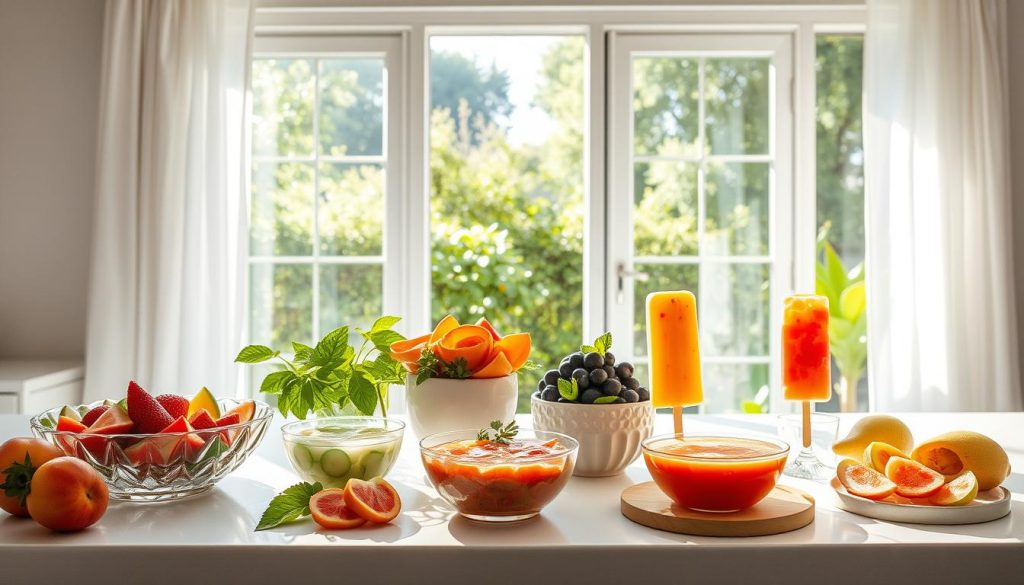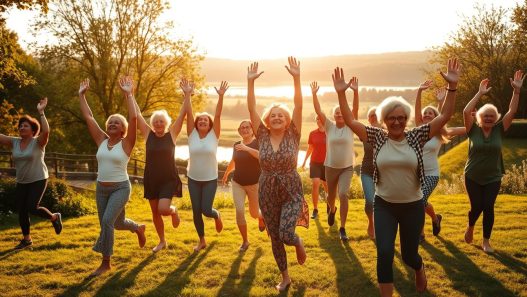As record summer temperatures continue to soar, it’s crucial to prioritize our health and safety. The recent BC Coroners Report highlighted the devastating impact of extreme heat, with 570 lives lost during the heat dome event in June. This alarming statistic underscores the need to adapt our wellness routines to cope with the extreme heat.
Understanding heat-related illnesses and implementing effective hydration strategies are vital components of a wellness routine during a heat wave. By making informed adjustments to our daily habits, we can mitigate the risks associated with summer health issues and stay healthy.
Key Takeaways
- Understand the risks of heat-related illnesses during extreme heat events.
- Implement effective hydration strategies to stay safe.
- Modify your daily routine to cope with record summer temperatures.
- Prioritize your health and safety during a heat wave.
- Stay informed about summer health issues and wellness routines.
Understanding Heat Domes: The Science Behind Extreme Temperature Events
As temperatures soar to record highs, understanding the phenomenon of heat domes becomes crucial for mitigating their impact on our health. A heat dome is essentially a high-pressure system that traps hot air beneath it, creating a dome of heat over a region.
What Causes Heat Domes to Form
Heat domes are caused by a persistent high-pressure system that remains stationary over an area, trapping hot air and preventing it from dissipating. This phenomenon is often associated with clear skies and dry conditions, which allow more sunlight to heat the ground.
Why Heat Domes Are Becoming More Common
Climate change is a significant factor in the increasing frequency and severity of heat domes. As global temperatures rise, the conditions that lead to heat domes are becoming more common.
Health Risks Associated with Prolonged Heat Exposure
Immediate Physical Effects
Prolonged exposure to extreme heat can lead to immediate physical effects such as dehydration, heat exhaustion, and heat stroke.
Long-term Health Concerns
Long-term exposure to heat stress can exacerbate existing health conditions, such as cardiovascular disease and respiratory issues.
| Health Risk | Description |
|---|---|
| Dehydration | Loss of fluids due to excessive sweating |
| Heat Exhaustion | Condition caused by overheating, often with heavy sweating and pale skin |
| Heat Stroke | Life-threatening condition with body temperature above 103°F |
Recognizing Heat-Related Illnesses: Signs You Shouldn’t Ignore
As temperatures soar, it’s crucial to recognize the signs of heat-related illnesses to prevent serious health complications. Heat-related illnesses encompass a range of conditions, from mild to severe, that occur when the body is unable to cool itself properly.
Heat Exhaustion vs. Heat Stroke: Know the Difference
Heat exhaustion is a precursor to heat stroke and is characterized by heavy sweating, pale skin, fast and weak pulse, nausea or vomiting, and dizziness. Heat stroke is a more severe condition where the body’s temperature regulation fails, leading to high body temperature, confusion, and even loss of consciousness.
Warning Signs Your Body Is Overheating
Signs that your body is overheating include muscle cramps, headaches, and fatigue. If you or someone else is experiencing these symptoms, it’s essential to seek shade, hydrate, and rest.
When to Seek Medical Attention
If symptoms worsen or if you experience confusion, seizures, or loss of consciousness, seek medical attention immediately. Heat stroke is a medical emergency.
Emergency Response Steps
- Call emergency services
- Move the person to a cooler place
- Remove excess clothing
- Use cool water or ice packs to cool the person
| Condition | Symptoms | Action |
|---|---|---|
| Heat Exhaustion | Heavy sweating, pale skin, fast and weak pulse, nausea or vomiting, dizziness | Rest, hydrate, seek shade |
| Heat Stroke | High body temperature, confusion, loss of consciousness | Seek medical attention immediately |
Hydration Strategies During Extreme Heat
As temperatures soar during a heat dome, staying hydrated becomes a critical aspect of maintaining overall health. The human body relies heavily on water to regulate its temperature, transport nutrients, and maintain cellular health.
Optimal Daily Water Intake During Heat Waves
The amount of water an individual needs can vary significantly based on factors such as age, sex, weight, and activity level. Generally, health experts recommend drinking at least eight glasses of water a day, but this can increase to 10-12 glasses during extreme heat or when engaging in strenuous activities.
Electrolyte Replacement: Beyond Plain Water
While plain water is essential, it’s also important to replenish electrolytes lost through sweat. Electrolytes like sodium, potassium, and calcium are crucial for maintaining proper fluid balance and nerve function. Consuming electrolyte-rich beverages or supplements can help prevent dehydration.
Foods That Help You Stay Hydrated
Incorporating foods with high water content into your diet can contribute to your daily hydration needs. Examples include watermelon, cucumbers, and celery. These foods not only provide water but also essential nutrients.
Hydration Tracking Methods
To ensure you’re staying hydrated, consider using a hydration tracking app or monitoring the color of your urine. Ideally, it should be pale yellow. Here’s a simple table to track your daily water intake:
| Time of Day | Water Intake (oz) | Cumulative Total (oz) |
|---|---|---|
| 8:00 AM | 16 | 16 |
| 12:00 PM | 16 | 32 |
| 4:00 PM | 16 | 48 |
| 8:00 PM | 16 | 64 |
Heat Dome Wellness: Adapting Your Health Routine to Record Summer Temperatures
As temperatures soar during a heat dome, it’s crucial to adjust our daily health routines to maintain wellness. The extreme heat can impact various aspects of our health, from physical performance to skin health.
Modifying Your Exercise Schedule
During extreme heat events, it’s essential to adjust our exercise schedules to avoid heat-related illnesses. This may involve scheduling physical activity during cooler parts of the day.
Best Times of Day for Physical Activity
The best times for exercise during a heat dome are early morning or late evening when temperatures are relatively lower. Avoiding the peak sun hours between 10 am and 4 pm can significantly reduce the risk of heat exhaustion.
Adjusting Intensity and Duration
It’s also important to adjust the intensity and duration of your workouts. Reducing the length and vigor of your exercise sessions can help your body cope with the heat stress.
| Activity | Recommended Adjustment | Benefits |
|---|---|---|
| Outdoor Running | Switch to early morning or late evening | Avoids peak heat hours |
| High-Intensity Workouts | Reduce intensity and duration | Lessens heat stress on the body |
| Outdoor Cycling | Choose shaded routes | Reduces direct sun exposure |
Adapting Your Skincare Routine
Extreme heat can also affect our skin, making it necessary to adapt our skincare routines. Using lighter, oil-free moisturizers and increasing the frequency of cleansing can help manage sweat and oil production.
Medication Considerations During Extreme Heat
Certain medications can increase the risk of heat-related illnesses. It’s crucial to consult with healthcare providers about potential risks and necessary precautions when taking medications during a heat dome.
By making these adjustments to our health routines, we can better protect ourselves against the adverse effects of extreme heat and maintain our overall wellness.
Creating a Heat-Resistant Home Environment
As temperatures soar during a heat dome, creating a cool home environment becomes essential for comfort and health. One of the most effective ways to achieve this is by implementing strategies that don’t rely on air conditioning.
Cooling Strategies Without Air Conditioning
There are several methods to cool your home without using air conditioning. One approach is to use natural ventilation by opening windows at night to let cool air in, then closing them during the day to retain that coolness.
- Use cross-ventilation by opening windows on opposite sides of the house.
- Employ window fans or whole-house fans to pull hot air out.
- Utilize shades or curtains to block direct sunlight.
Optimal Use of Fans and Air Flow
Fans are an energy-efficient way to keep your home cool. To maximize their effectiveness, use them in conjunction with other cooling strategies.
“Fans can make you feel up to 4°F cooler by creating a wind chill effect.”
To optimize air flow:
- Place ceiling fans to circulate air throughout the room.
- Use box fans in windows to pull hot air out.
- Position floor fans to create a cooling breeze.
Heat-Blocking Window Treatments and Home Modifications
Modifying your home to block heat can significantly reduce indoor temperatures. Consider installing:
- Thermal curtains or blackout shades.
- Window films that reflect sunlight.
- Awnings or umbrellas to shade windows.
DIY Cooling Solutions
For those on a budget, there are several DIY cooling solutions you can implement:
| Solution | Description | Cost |
|---|---|---|
| DIY Window Shades | Create your own shades using materials like cardboard or fabric. | $0 – $20 |
| Cooling Curtains | Soak curtains in water and hang them to dry, creating a cooling effect. | $0 – $10 |
| Homemade Cooling Packs | Fill plastic bottles with water and freeze them to use as cooling packs. | $0 |
By implementing these strategies, you can create a heat-resistant home environment that keeps you cool and comfortable during extreme heat events.
Nutritional Adjustments for Extreme Heat
During periods of extreme heat, adjusting our nutritional intake can significantly impact our well-being. The right foods can help our bodies regulate temperature, maintain energy, and stay hydrated.
Foods to Avoid During Heat Waves
Certain foods can exacerbate the effects of heat. It’s advisable to avoid heavy, rich, and spicy foods as they can increase body temperature and cause discomfort. Processed meats and high-protein foods can also put a strain on the body, making it harder to cope with the heat.
Cooling Meals That Require Minimal Cooking
Opting for meals that require minimal cooking can help keep your kitchen cool and reduce the risk of heat exhaustion. Consider salads, cold soups, and fresh fruits
| Food | Benefits |
|---|---|
| Cucumbers | High water content, helps with hydration |
| Leafy Greens | Rich in antioxidants, easy to digest |
| Yogurt | Cooling effect, good source of protein |
Nutrient Needs That Change in Hot Weather
Hot weather can affect our nutrient needs. For instance, we may need more electrolytes to replace those lost through sweating. Additionally, staying hydrated is crucial, but it’s also important to consume foods that are rich in vitamins and minerals.
Easy No-Cook Recipe Ideas
- No-Cook Oatmeal with Fresh Fruits
- Gazpacho Salad
- Avocado and Tomato Salad
By making these nutritional adjustments, we can better cope with extreme heat and maintain our overall health.
Sleep Strategies When Temperatures Won’t Drop
Sleeping comfortably during a heat wave requires more than just a good mattress; it demands a strategic approach. As temperatures soar, our ability to fall and stay asleep can be significantly compromised. Implementing effective sleep strategies can make a substantial difference in the quality of rest we get during these hot periods.
Creating a Cool Sleeping Environment
A cool sleeping environment is crucial for a good night’s sleep. To achieve this, consider using blackout curtains or shades to keep the sun’s rays from heating up your bedroom. Keeping your bedroom cool can also be achieved by using fans or air conditioning units. If you don’t have air conditioning, using a fan with a bowl of ice in front of it can help lower the temperature.
Pre-Bedtime Routines for Better Sleep in Heat
Establishing a pre-bedtime routine can signal to your body that it’s time to sleep. This can include taking a cool shower, practicing relaxation techniques such as deep breathing or meditation, or reading a book in a cool, dimly lit room. Avoiding screens and electronic devices at least an hour before bedtime can also improve sleep quality.
When to Adjust Your Sleep Schedule
In extreme heat, adjusting your sleep schedule might be necessary. Going to bed earlier or later to avoid the hottest part of the night can help. However, maintaining a consistent sleep schedule is generally recommended for overall sleep health.
Cooling Products Worth Considering
There are various cooling products on the market designed to help keep you cool during sleep. These include cooling mattress pads, breathable bedding, and cooling pillows. Investing in such products can enhance your sleep environment.
| Product | Description | Benefits |
|---|---|---|
| Cooling Mattress Pads | Designed to regulate body temperature | Improved sleep quality, reduced night sweats |
| Breathable Bedding | Made from materials that allow for airflow | Enhanced comfort, cooler sleeping surface |
| Cooling Pillows | Filled with cooling gel or designed for better airflow | Cooler head and neck, improved sleep |
Protecting Vulnerable Populations During Heat Domes
During extreme heat events, it’s crucial to prioritize the well-being of those most susceptible to heat-related illnesses. Vulnerable populations, including children, the elderly, and individuals with chronic health conditions, require special attention to prevent serious health complications.
Special Considerations for Children and Infants
Children and infants are particularly vulnerable to heat stress due to their developing regulatory systems. Keep them hydrated by offering frequent breastfeeds or formula feeds, and for older children, provide cool drinks. Ensure they stay in cool environments, and avoid leaving them in vehicles or direct sunlight.
Elderly Care During Extreme Heat Events
The elderly are at higher risk due to potential pre-existing medical conditions and medications that can affect their body’s ability to regulate temperature. Regular check-ins by family or caregivers can help monitor their condition and ensure they stay cool and hydrated.
Supporting Those with Chronic Health Conditions
Individuals with chronic health conditions, such as heart disease or diabetes, may need to adjust their treatment plans during heatwaves. Consult healthcare providers for specific advice on managing their condition in extreme heat.
Creating a Heat Safety Plan
A heat safety plan should include identifying cool spaces in the home, having a backup power source for medical equipment, and staying informed about weather forecasts. Prepare a kit with essentials like water, medications, and a first-aid kit to ensure readiness for extreme heat events.
Mental Health and Heat: Managing Stress During Temperature Extremes
The sweltering heat of summer isn’t just uncomfortable; it can also have profound effects on our mental health, requiring us to rethink our stress management strategies. As temperatures soar, it’s essential to understand the impact of heat on our well-being and adopt effective coping mechanisms.
How Heat Affects Mood and Cognitive Function
Extreme heat can lead to irritability, anxiety, and decreased cognitive performance. Research has shown that high temperatures can affect the brain’s ability to regulate emotions, leading to increased stress levels. “The heat can make you feel like you’re walking on eggshells, waiting for the other shoe to drop,” says Dr. Jane Smith, a psychologist specializing in environmental psychology.
Stress Reduction Techniques for Hot Weather
Staying calm during heatwaves requires proactive stress management. Techniques such as deep breathing exercises, meditation, and yoga can help mitigate the effects of heat stress. Engaging in these activities in a cool environment can enhance their effectiveness.
Creating Cooling Mental Breaks Throughout the Day
Creating mental breaks is crucial for maintaining mental health during extreme heat. This can involve:
- Engaging in indoor activities that are calming and enjoyable
- Practicing mindfulness or meditation
- Taking cool showers or baths to lower body temperature
Indoor Activities for Heat Wave Days
Indoor activities can provide a much-needed respite from the heat. Consider visiting museums, libraries, or shopping malls that are air-conditioned. You can also engage in hobbies like reading, puzzles, or indoor gardening to create a cooling mental break.
Community Resources and Heat Emergency Planning
The impact of heat domes can be mitigated with the right community resources and emergency planning. Communities often have resources available to help residents cope with extreme heat.
Identifying Cooling Centers in Your Area
During a heatwave, cooling centers serve as safe havens where people can cool off. To find one near you, check local government websites or community boards. Many libraries, community centers, and public buildings open their doors as cooling centers.
Building a Heat Emergency Kit
Preparing a heat emergency kit is crucial. Include essentials like:
- Water and non-perishable snacks
- A first-aid kit
- Medications and necessary prescriptions
- A battery-powered fan or other cooling devices
Checking on Neighbors and Community Support
Community support is vital during heat emergencies. Check on vulnerable neighbors, such as the elderly or those with chronic health conditions. Organizing community support networks can significantly enhance overall resilience.
Heat-Related Resources and Hotlines
For additional support, keep handy heat-related resources and hotlines. These can provide critical information and assistance during heat emergencies.
Conclusion: Building Heat Resilience for Future Summers
As we navigate the challenges of extreme heat, building heat resilience is crucial for protecting our health and well-being during future summers. By understanding the risks associated with heat domes and taking proactive steps to adapt our routines and environments, we can reduce the likelihood of heat-related illnesses.
Implementing the strategies discussed, such as modifying exercise schedules, optimizing home cooling, and staying hydrated, can significantly enhance our ability to cope with extreme temperatures. As we move forward, prioritizing heat resilience will be essential for safeguarding vulnerable populations and promoting community well-being.
By taking a proactive approach to heat resilience, we can better prepare for future summers and minimize the risks associated with extreme heat events, ultimately creating a healthier and more resilient community.






